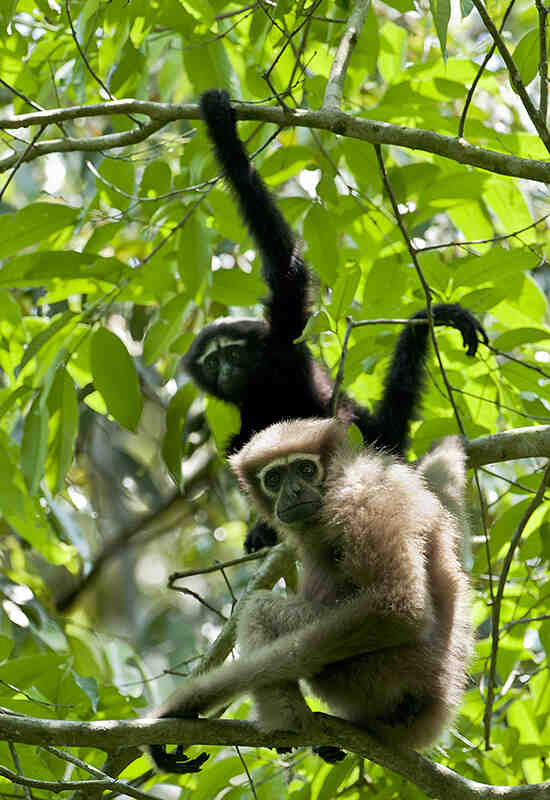Hoolock
IUCN
LCBasic Information
Scientific classification
- name:Hoolock
- Scientific Name:Hoolock gibbon, gibbon, call monkey, black monkey
- Outline:Primates
- Family:Primates Hylobatidae Hoolock
Vital signs
- length:45-65cm
- Weight:10-14kg
- lifetime:20-30year
Feature
Two white eyebrows are impressive
Distribution and Habitat
Hoobrowed gibbons are endemic to the Burma-China subregion of the Oriental world. In China, they are only found in Baoshan, Tengchong, Yingjiang and Longchuan west of the Nujiang River in western Yunnan. Outside China, they are found in Myanmar, Bangladesh and Assam in northeastern India. Hoobrowed gibbons mainly live in the southern subtropical monsoon evergreen broad-leaved forests. In western Yunnan, they mostly live in mid-mountain moist evergreen broad-leaved forests and deciduous broad-leaved forests between 2000-2500 meters above sea level, and often migrate vertically downward in winter.
Appearance
The head of the white-browed gibbon is very small, with a short and flat face. The body length is 45 to 65 cm, the weight is 10 to 14 kg, and it has no tail. The front limbs are obviously longer than the hind limbs. The body hair is fluffy. The body color of male animals is mostly dark brown, but the hair on the penis is white. In addition, there is a clear white line near the forehead, like a white eyebrow, hence the name. The male and female are different in color. The male is brown-black or dark brown, with white eyebrows. The hair on the top of the head is longer and draped to the back, so the top of the head is flat, without upright tufts of crown hair. Most females are gray or grayish yellow, with lighter eyebrows, wide faces and short gray hair, and the face is lighter and white.
The white-browed gibbon mainly feeds on a variety of wild fruits, fresh branches and leaves, flower buds, etc., and also eats insects and small birds.
The white-browed gibbon mates from September
Details
Hoobrow gibbon is a larger type of gibbon.

Hoobrow gibbon was once considered to be one species with three subspecies. In 2006, the IUCN Primate Specialist Group agreed to divide the white-browed gibbon into two species: the eastern white-browed gibbon and the western white-browed gibbon. The Tianxing gibbon is distributed in the Gaoligong Mountain area of China.
The white-browed gibbon is a monogamous animal that forms a small group with its young, usually 3-5 in a group, occupying an area of about 30-40 hectares. It also makes loud calls every morning. Its calls are loud and can be heard from miles away. The sound is like "Hu-ke, Hu-ke", so it is also called Hu-ke ape, or Hu-ke ape.
In 2005, there were an estimated 200-280 white-browed gibbons in Bangladesh, and the total population of white-browed gibbons in northeastern India was about 2,600. The global white-browed gibbon population is on a downward trend. In 2009, the State Forestry Administration's survey of China's key terrestrial wildlife resources found that there were about 680 white-browed gibbons.
The main factor endangering the white-browed gibbon is the destruction of its habitat, especially along the China-Myanmar border, where deforestation is increasing on an increasing scale and has not been effectively stopped. Slash-and-burn farming by local ethnic groups also threatens large areas of white-browed gibbon habitat; hunting is a secondary threat factor; the population is fragmented and the groups are far apart. Severe inbreeding depression has weakened the survival ability and reproductive performance of offspring; sexually mature young apes that leave the group lose the opportunity to reproduce because they cannot find a mate.
The white-browed gibbon has been listed as a first-class protected wild animal in China. There are now two nature reserves (Gaoligongshan Nature Reserve [national level] and Yingjiang Tongbiguan Nature Reserve [provincial level]) to protect the white-browed gibbon. These two nature reserves were built between 1980 and 1986, with a total area of 158,000 hectares. The number of white-browed gibbons in the reserve has decreased due to the publicity and law enforcement education of the Wildlife Protection Law, and the local people's awareness of wildlife protection has increased. They have been able to protect the white-browed gibbons more consciously, and poaching has been basically stopped. However, only half or even less than half of the white-browed gibbons live in the reserve. Especially along the China-Myanmar border, there is a lack of cooperation and coordination between the reserve and the international community, and the population is still declining.
Listed in the 2008 Red List of Endangered Species of the World Conservation Union (IUCN) ver 3.1 - Endangered (EN).
Listed in the CITES Appendix I of the Washington Convention as a protected animal.
Protect wild animals and eliminate game.
Maintaining ecological balance is everyone's responsibility!








